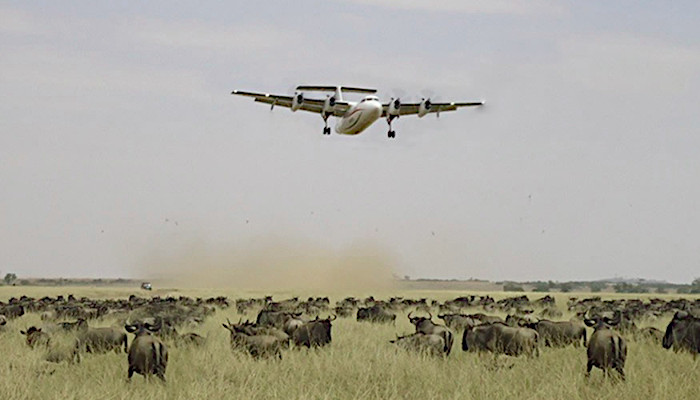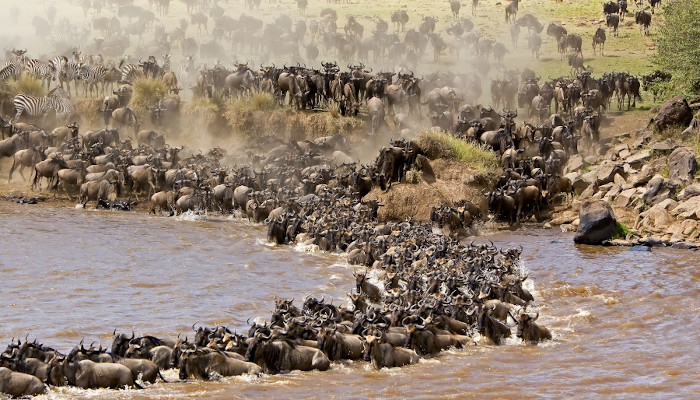Katavi National Park
Katavi National Park is a relatively untouched wilderness paradise, situated in the western area of Tanzania. The park boasts a wonderful array of habitats, which range from flood plains of thick reeds and dense waterways that teem with hippo and crocodile to woodlands, open grasslands, forests and pristine seasonal lakes. Visitors to the area can seek out the legendary tamarind tree, which is said to house the spirit of a great huntsman named Katabi. Here, they can place an offering at the base of the tree in memory of this exceptional hunter.
It offers un-spoilt wildlife viewing in the country’s third-largest national park, in a remote location far off the beaten track. The national park is Africa at its most wild — unadulterated bush settings, spectacular views, and rich wildlife.
With over 400 species of birds, Katavi is a great place for birdwatchers. Large flocks of storks like saddle bills, open-billed and spoon bills as well as African fish eagles, Bateleurs, lilac breasted rollers, crested barbets and paradise flycatchers are but a few on the long list of birds in Katavi.
Guests can enjoy game watching and bird watching on game drives. Lodges in the park also offer walking safaris and night game drives so you will be able to experience a larger variety of animals and plants more intimately.
Size: 4,471 sq km (1,727 sq miles)
Distance from Arusha: over 1,000 km (620 miles) – about 4 hours flying time
Katavi National park is the third largest park in Tanzania. It is also by far one of the least visited in the country, making it a truly untouched wildlife paradise. The park is primarily fed by the Katuma River which in the rainy season – April and May – transforms the park into a wetland. Lake Chada and Lake Katavi are both seasonal lakes which are situated within the park boundaries. In terms of vegetation the park hosts a varied mix of bush land, Miombo forests, riverine forests as well as grasslands.
The Katisunga plains in the heart of the park attracts large numbers of wildlife and it is one of the few parks where visitors can catch a glimpse of both the roan and sable antelope in the same place. Other animals grazing here are zebra, hartebeest, eland, giraffe and defassa waterbuck. Katavi is also one of the last parks that boasts massive herds of buffalo; some herds easily reaching a thousand animals or more. A healthy population of roughly 3000 elephants also reside in the park. Predators such as cheetahs, hyenas, jackals and servals are also present in the area and the resident prides of lions are always around looking for their next meal. Leopards also call Katavi home.
Wildlife include large animal herds, particularly of Cape Buffaloes, zebras, wildebeest, giraffes, and elephants, plus along the Katuma river, crocodiles and hippopotami which upon annual dry seasons results in mudholes that can be packed with hundreds of hippos. Carnivorous animals that roam this park are cheetahs, wild dogs, hyenas, leopards, and lions. Some sources claim a very high biodiversity in the park, although there are also reports of wildlife decline due to illegal hunting and poaching, presumably 'bushmeat' sustenance.[4] Katavi has fewer human visitors and jeeps conducting game drives than other Tanzania parks.
All flights will require landing on a dirt airstrip; the Ikuu airstrip (near the Ikuu Rangerpost) has minimal services. It is very approximately a three-hour flight from Katavi to Dar es Salaam and two-hours flight to Mwanza via a small, bush-compatible light aircraft. A flight to Arusha is similarly ~3 hours distant.
To visit Katavi, the dry season – June to October – is by far the best time to see animals. The Katuma River is one of the only sources of water in the dry season and is the lifeline for creatures both large and small when they congregate along the river to drink and bath. Then, when the last lakes and swamps are drying, up to a thousand hippos at times would huddle together for that last bit of water. Large crocodiles can be seen basking in the sun or in the remaining mud pools.
A yellow fever vaccination certificate. Also take medical evacuation insurance, malaria prophylaxis (consult your doctor), sun protection gear and creams, insect repellent and anti-histamine creams. Tsetse bites are harmless but painful, and often cause swellings that itch for days. Due to altitude mosquitoes or tsetse flies are not that common as at lower altitudes.

Best time to Visit Tanzania
The best wildlife viewing months in Tanzania are during the Dry season from late June to October. The best chance of seeing the wildebeest migration in the Serengeti is during June and July and the time to see the wildebeest calving is late January to February. The southern and western circuit parks are best visited during the Dry season (June to October).
Best Time : June to October ((Little to no rainfall)), June-July and January-February (Serengeti for the wildebeest migration and calving)
High Season : July to March (northern circuit parks; they get crowded), July to October (southern and western circuit parks; they don't really get crowded any time of the year)
Low Season: April and May (northern circuit parks still get quite a few visitors unlike the southern and western circuit parks, where many lodges close down)
Worst Weather: March and April (Peak of Wet season)
Tanzania Safari Packages
Choice of Safari holidays in Tanzania& tours from specialist, expert ... Small group travel: Departs most Sundays and selected Wednesdays throughout the year.

4 Days Tanzania Group Joining Budget Safari
4 Days Tanzania Group Joining Budget Safari - Adventure budget camping safari Tanzania. Experience unforgettable memorable Tanzania wildlife tour on this Tanzania ...

5 Days Tanzania Budget Campng & lodge Safari
5 Days Budget Tour is special tour package takes to Serengeti and other game ... takes to During this camping adventure in Tanzania National Parks by ... The begins of 5-Days Tanzania Budget Tour by picking you up from the hotel at Arusha ... Day 5: safari from Serengeti to Arusha via Ngorongoro crater.

7 Days Tanzania Budget Safari
This 7 day camping safari allows you to experience the highlights of the Northern Safari Circuit. You will experience breathtaking wildlife in the midst of some of the most diverse landscapes. You will also visit the world famous Serengeti National Park....

8 Days Tanzania Wildlife Camping and Lodge Safari
The 8 days safari will allow you to witness the best of the wildlife and best of birding experiences as you traverse the northen circuit in your Tanzania Safari. Savour the moments as you spend in some of the best lodges and camps beknown to Tanzania game safari circuit.

12 Days Nothern Tanzania Budget Wildlife Safari
Our 12 days Tanzania Safari and Zanzibar tour package will is combination safari involve wildlife safari Lodge or Tented Camping Safaris and beach vacation to Zanzibar Island. 13 days Tanzania And Zanzibar beach Is best package for Family or group of Friends to the game park including Serengeti famous for wildebeest migration later fly to Zanzibar for beach tour and vacation.

14 Days Kenya and Tanzania Wildlife Luxury Safari with Zanzibar Beach Holiday
Safari in the Masai Mara & paradise beaches on Zanzibar ... Luxury tailormade safari and beach holidays in Kenya .... Kenya and Tanzania tour, 14 days.....

20 Days Kenya Tanzania Gudget Group Safari with Zanzibar Beach Holiday
Kenya Budget Safaris | Tanzania Holiday | WildRace Africa Safari Tours ... small group tours and Safaris in Kenya and Tanzania Combined, Kenya and Tanzania ... parks Maasai Mara and Serengeti Safaris, Kenya wildlife and beach Holiday .... to amazing East African Safari destinations — Kenya, Tanzania, and Zanzibar.